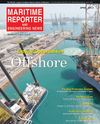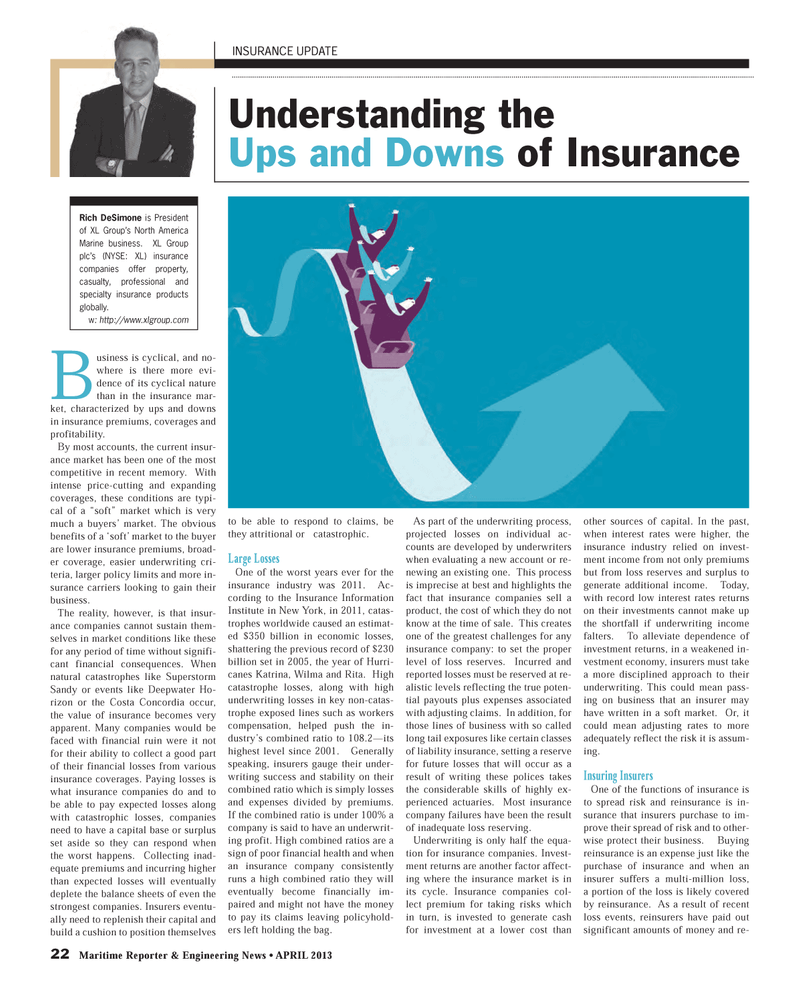
Page 22: of Maritime Reporter Magazine (April 2013)
Offshore Energy Edition
Read this page in Pdf, Flash or Html5 edition of April 2013 Maritime Reporter Magazine
22 Maritime Reporter & Engineering News ? APRIL 2013 Business is cyclical, and no-where is there more evi-dence of its cyclical nature than in the insurance mar- ket, characterized by ups and downs in insurance premiums, coverages and profitability. By most accounts, the current insur- ance market has been one of the most competitive in recent memory. With intense price-cutting and expanding coverages, these conditions are typi-cal of a ?soft? market which is very much a buyers? market. The obvious benefits of a ?soft? market to the buyer are lower insurance premiums, broad-er coverage, easier underwriting cri-teria, larger policy limits and more in- surance carriers looking to gain their business. The reality, however, is that insur- ance companies cannot sustain them-selves in market conditions like these for any period of time without signifi-cant financial consequences. When natural catastrophes like Superstorm Sandy or events like Deepwater Ho-rizon or the Costa Concordia occur, the value of insurance becomes very apparent. Many companies would be faced with financial ruin were it not for their ability to collect a good part of their financial losses from various insurance coverages. Paying losses is what insurance companies do and to be able to pay expected losses along with catastrophic losses, companies need to have a capital base or surplus set aside so they can respond when the worst happens. Collecting inad-equate premiums and incurring higher than expected losses will eventually deplete the balance sheets of even the strongest companies. Insurers eventu-ally need to replenish their capital and build a cushion to position themselves to be able to respond to claims, be they attritional or catastrophic. Large LossesOne of the worst years ever for the insurance industry was 2011. Ac- cording to the Insurance Information Institute in New York, in 2011, catas- trophes worldwide caused an estimat-ed $350 billion in economic losses, shattering the previous record of $230 billion set in 2005, the year of Hurri-canes Katrina, Wilma and Rita. High catastrophe losses, along with high underwriting losses in key non-catas-trophe exposed lines such as workers compensation, helped push the in-dustry?s combined ratio to 108.2?its highest level since 2001. Generally speaking, insurers gauge their under- writing success and stability on their combined ratio which is simply losses and expenses divided by premiums. If the combined ratio is under 100% a company is said to have an underwrit-ing profit. High combined ratios are a sign of poor financial health and when an insurance company consistently runs a high combined ratio they will eventually become financially im-paired and might not have the money to pay its claims leaving policyhold-ers left holding the bag. As part of the underwriting process, projected losses on individual ac-counts are developed by underwriters when evaluating a new account or re-newing an existing one. This process is imprecise at best and highlights the fact that insurance companies sell a product, the cost of which they do not know at the time of sale. This creates one of the greatest challenges for any insurance company: to set the proper level of loss reserves. Incurred and reported losses must be reserved at re-alistic levels reflecting the true poten-tial payouts plus expenses associated with adjusting claims. In addition, for those lines of business with so called long tail exposures like certain classes of liability insurance, setting a reserve for future losses that will occur as a result of writing these polices takes the considerable skills of highly ex-perienced actuaries. Most insurance company failures have been the result of inadequate loss reserving.Underwriting is only half the equa-tion for insurance companies. Invest-ment returns are another factor affect- ing where the insurance market is in its cycle. Insurance companies col-lect premium for taking risks which in turn, is invested to generate cash for investment at a lower cost than other sources of capital. In the past, when interest rates were higher, the insurance industry relied on invest-ment income from not only premiums but from loss reserves and surplus to generate additional income. Today, with record low interest rates returns on their investments cannot make up the shortfall if underwriting income falters. To alleviate dependence of investment returns, in a weakened in-vestment economy, insurers must take a more disciplined approach to their underwriting. This could mean pass- ing on business that an insurer may have written in a soft market. Or, it could mean adjusting rates to more adequately reflect the risk it is assum-ing. Insuring Insurers One of the functions of insurance is to spread risk and reinsurance is in-surance that insurers purchase to im-prove their spread of risk and to other- wise protect their business. Buying reinsurance is an expense just like the purchase of insurance and when an insurer suffers a multi-million loss, a portion of the loss is likely covered by reinsurance. As a result of recent loss events, reinsurers have paid out significant amounts of money and re-INSURANCE UPDATE Understanding the Ups and Downs of InsuranceRich DeSimone is President of XL Group?s North America Marine business. XL Group plc?s (NYSE: XL) insurance companies offer property, casualty, professional and specialty insurance products globally. w: http://www.xlgroup.com MR #4 (18-25).indd 22MR #4 (18-25).indd 224/1/2013 1:39:36 PM4/1/2013 1:39:36 PM

 21
21

 23
23
